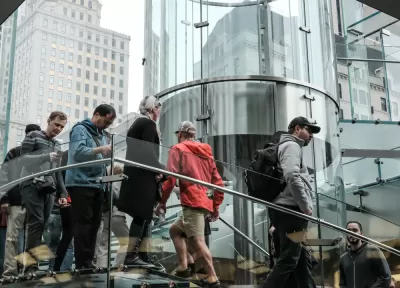The number of people commuting 20 minutes or more each way dropped by close to half a million, while short commutes rose slightly.

New data shows that the number of workers with long commutes (more than 20 minutes each way) in the Seattle area dropped sharply during the pandemic, while "the number of people with short commutes actually increased a little."
As reported by Gene Balk, Nielsen survey data shows "In the period from February 2020 to February 2021, about 318,000 workers age 21 and older in the Seattle metro area were not typically commuting," as compared with 125,000 in the prior year. "That pencils out to 193,000 fewer commuters just because of remote work. On top of that, the number of people in our area who were not employed, for whatever reason, increased by 74,000." In short, "100% of the net decline in commuting was due to those folks with commutes of 20 minutes or longer." Meanwhile, the number of short commutes, particularly those under ten minutes, increased slightly.
One explanation for this disparity is the correlation between average commute times and professions. "The data shows that, on average, people with shorter commutes are more likely to work jobs that could be categorized as 'blue collar' — and these were often jobs deemed essential during the pandemic (such as food service and grocery, transportation, delivery and retail)," jobs which typically do not have remote work options. "The data shows roughly half (49%) of the Seattle-area workforce with a job categorized as blue collar had a commute time of less than 20 minutes. In comparison, only about 37% of white-collar workers had commute times of less than 20 minutes."
FULL STORY: A quarter of a million long commutes disappeared during the pandemic in the Seattle area

Study: Maui’s Plan to Convert Vacation Rentals to Long-Term Housing Could Cause Nearly $1 Billion Economic Loss
The plan would reduce visitor accommodation by 25,% resulting in 1,900 jobs lost.

North Texas Transit Leaders Tout Benefits of TOD for Growing Region
At a summit focused on transit-oriented development, policymakers discussed how North Texas’ expanded light rail system can serve as a tool for economic growth.

Using Old Oil and Gas Wells for Green Energy Storage
Penn State researchers have found that repurposing abandoned oil and gas wells for geothermal-assisted compressed-air energy storage can boost efficiency, reduce environmental risks, and support clean energy and job transitions.

Private Donations Propel Early Restoration of Palisades Playground
Los Angeles has secured over $1.3 million in private funding to restore the Pacific Palisades playground months ahead of schedule, creating a modern, accessible space that supports community healing after recent wildfires.

From Blight to Benefit: Early Results From California’s Equitable Cleanup Program
The Equitable Community Revitalization Grant (ECRG) program is reshaping brownfield redevelopment by prioritizing projects in low-income and environmental justice communities, emphasizing equity, transparency, and community benefits.

Planting Relief: Tackling Las Vegas Heat One Tree at a Time
Nevada Plants, a Las Vegas-based nonprofit, is combating the city’s extreme urban heat by giving away trees to residents in underserved neighborhoods, promoting shade, sustainability, and community health.
Urban Design for Planners 1: Software Tools
This six-course series explores essential urban design concepts using open source software and equips planners with the tools they need to participate fully in the urban design process.
Planning for Universal Design
Learn the tools for implementing Universal Design in planning regulations.
Ascent Environmental
Borough of Carlisle
Institute for Housing and Urban Development Studies (IHS)
City of Grandview
Harvard GSD Executive Education
Toledo-Lucas County Plan Commissions
Salt Lake City
NYU Wagner Graduate School of Public Service





























